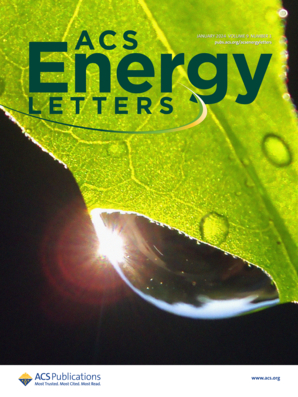Unveiling the Role of Guanidinium for Enhanced Charge Extraction in Inverted Perovskite Solar Cells
IF 19.3
1区 材料科学
Q1 CHEMISTRY, PHYSICAL
引用次数: 0
Abstract
The incorporation of guanidinium (Gua) cations has significantly enhanced the optoelectronic properties of various perovskite compositions. When combined with other A-site cations in perovskite solar cells (PSCs), Gua cations not only enhance the power conversion efficiency of the solar cells but often improve their overall stability. While most studies examining the impact of Gua focus on PSCs with the n-i-p (conventional) structure, fewer have investigated its effects on the mechanism and performance of the p-i-n (inverted) structure. We investigate how partially substituting A-site cations with Gua affects the performance of PSCs and the associated charge carrier dynamics. Enhanced performance is observed in Gua-substituted inverted PSCs, primarily due to improved short-circuit current density and fill factor values. Our spectroscopic and microscopic analyses reveal that these enhancements stem from accelerated charge transport within the perovskite layer combined with inhibited ion migration following Gua incorporation, attributed to the reduction of localized inhomogeneities, which also notably enhance device stability. Our findings elucidate the role of Gua in inverted PSCs, showing negligible impact on open-circuit voltage but significant improvement in charge extraction efficiency. This contrasts with previous reports on conventional structures, where performance enhancement is primarily attributed to trap state reduction, resulting in higher open-circuit voltage.

揭示了胍在倒置钙钛矿太阳能电池中增强电荷萃取的作用
胍(Gua)阳离子的掺入显著提高了各种钙钛矿组合物的光电性能。当与钙钛矿太阳能电池(PSCs)中的其他a位阳离子结合时,Gua阳离子不仅提高了太阳能电池的功率转换效率,而且通常提高了太阳能电池的整体稳定性。虽然大多数研究关注的是Gua对具有n-i-p(传统)结构的psc的影响,但较少研究其对p-i-n(倒置)结构的机制和性能的影响。我们研究了用Gua部分取代a位阳离子如何影响psc的性能和相关的载流子动力学。在gua取代的倒置PSCs中观察到性能的增强,主要是由于改善了短路电流密度和填充因子值。我们的光谱和微观分析表明,这些增强源于钙钛矿层内加速的电荷传输,以及Gua掺入后抑制的离子迁移,这归因于局部不均匀性的减少,这也显著提高了器件的稳定性。我们的研究结果阐明了Gua在倒置PSCs中的作用,对开路电压的影响可以忽略不计,但对电荷提取效率有显著提高。这与之前关于传统结构的报告形成了对比,传统结构的性能增强主要归功于陷阱状态的减少,从而导致更高的开路电压。
本文章由计算机程序翻译,如有差异,请以英文原文为准。
求助全文
约1分钟内获得全文
求助全文
来源期刊

ACS Energy Letters
Energy-Renewable Energy, Sustainability and the Environment
CiteScore
31.20
自引率
5.00%
发文量
469
审稿时长
1 months
期刊介绍:
ACS Energy Letters is a monthly journal that publishes papers reporting new scientific advances in energy research. The journal focuses on topics that are of interest to scientists working in the fundamental and applied sciences. Rapid publication is a central criterion for acceptance, and the journal is known for its quick publication times, with an average of 4-6 weeks from submission to web publication in As Soon As Publishable format.
ACS Energy Letters is ranked as the number one journal in the Web of Science Electrochemistry category. It also ranks within the top 10 journals for Physical Chemistry, Energy & Fuels, and Nanoscience & Nanotechnology.
The journal offers several types of articles, including Letters, Energy Express, Perspectives, Reviews, Editorials, Viewpoints and Energy Focus. Additionally, authors have the option to submit videos that summarize or support the information presented in a Perspective or Review article, which can be highlighted on the journal's website. ACS Energy Letters is abstracted and indexed in Chemical Abstracts Service/SciFinder, EBSCO-summon, PubMed, Web of Science, Scopus and Portico.
 求助内容:
求助内容: 应助结果提醒方式:
应助结果提醒方式:


